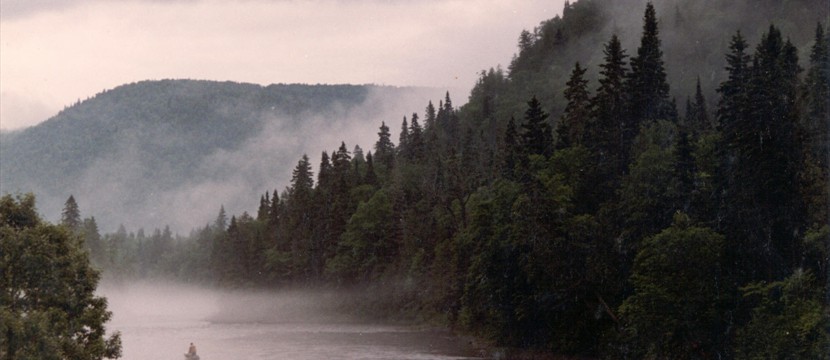
The crew pictured here were known as Montgomery's Men. Robert Hudson Montgomery was very active in the export of naval timber and other woods. When his brother-in-law, William Cuthbert, died in 1854, Montgomery took over Cuthbert’s timber mills along the Little Cascapedia and Bonaventure rivers. Under the ownership of the Montgomery family, business continued to prosper and exports increased. In 1895 the Montgomery Company had 3 lumber camps in the forests around the Grand Cascapedia River, a great distance from the sawmill. The most distant was at Loon Lake (now Lac Huard) and travelling to and from this Camp was very difficult and long. The men rarely came home until the drive was completed, except on rare occasions such as illness.

This is a photograph of a horse powered saw. In the late 1800s and early 1900s horses were used to power the saws for mills. The horses walked on a tread mill that powered the saws in the mill to cut the lumber.

Lumberjacks used horses to perform a variety of jobs. With the help of horses, the men in the photograph are building a cribbing on the side of the Moen Pool.

Lumberjacks used the river to transport lumber from the coast's interior to Chaleur Bay. This picture was taken in the spring or early summer during the log drive. It was very dangerous work. The log drive stopped in the 60s.

Lumberjacks used the river to transport lumber from the coast's interior to Chaleur Bay.

Logging scows were a common slight in the late 1800s and early 1900s, as they transported men and supplies up and down river. Since roads were still very scarce, all supplies had to be transported to the camps by river scows. Scows were also used to pull (by tug) lumber to waiting ships in the harbour. These ships were equipped with slings with which to load the lumber on deck. After the arrival of the railroad a spur line was installed running directly to the Mill so that the lumber could be more easily loaded onto the freight cars.

Up until the 1960s the Cascapedia River was used to transport large ‘log booms’ from the interior of the coast to Chaleur Bay. This practice was eventually banned because of its destructive impact on the salmon. Lumbering stirred up sediment in the water and consequently deprived salmon eggs of the oxygen they needed to survive. Additionally, the removal of tree roots along the river banks caused water run-off to flow into the river at a much faster rate. This helped create additional sediment and also made water levels rise and fall too rapidly.

The wood was collected in huge nets and pulled across the bay by a tug boat to the Bathurst Consolidated Mill.

Up until the 1960s the Cascapedia River was used to transport large ‘log booms’ from the interior of the coast to Chaleur Bay. This practice was eventually banned because of its destructive impact on the salmon. Lumbering stirred up sediment in the water and consequently deprived salmon eggs of the oxygen they needed to survive. Additionally, the removal of tree roots along the river banks caused water run-off to flow into the river at a much faster rate. This helped create additional sediment and also made water levels rise and fall too rapidly.

During the years that the mill was run by the Montgomery family the operation was very large and included many buildings on the property. By 1920 the forestry industry had begun to decline in this area as the virgin forests were becoming more difficult to reach, competition for lumber products was stronger from other countries, mainly the United States, and there was no longer any great demand for naval timber because of the steel-hulled ships. By 1925 Montgomerys closed their sawmill in New Richmond and in 1928 their holdings were acquired by N.B. International Paper.




 Photo courtesy of Jean MacWhirter Bujold
Photo courtesy of Jean MacWhirter Bujold
 1
1 2
2 3
3 4
4 5
5








